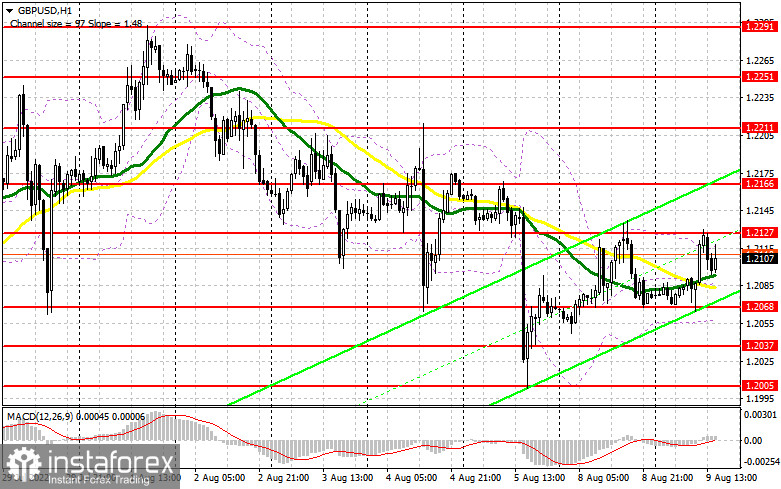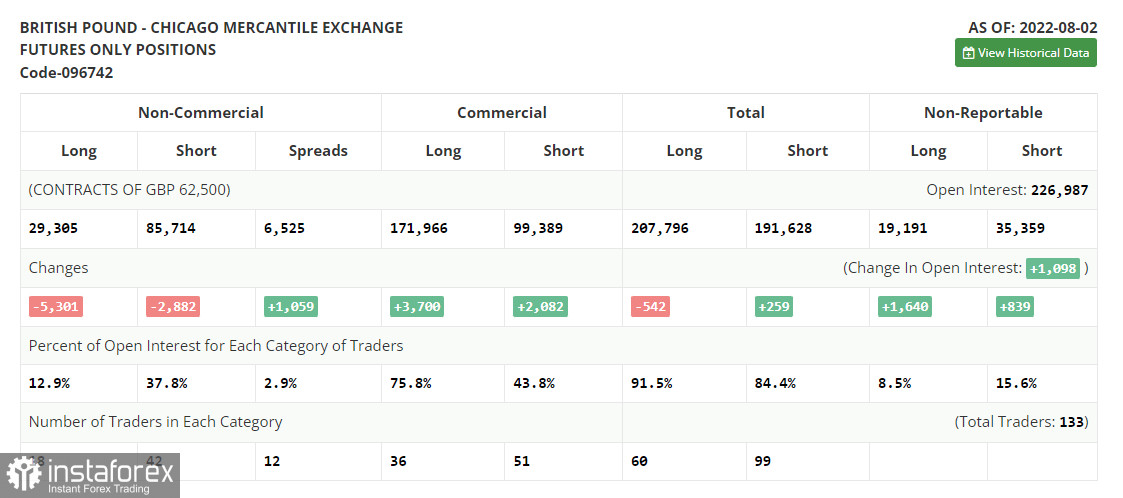In my morning forecast, I paid attention to the level of 1.2096 and recommended deciding on entering the market. Let's look at the 5-minute chart and figure out what happened there. The pound buyers gained a foothold above 1.2096, and the reverse test of this range from top to bottom led to the formation of a signal to open long positions. At the time of writing, the upward movement was about 20 points. For the second half of the day, the technical picture was revised, but the chances of buyers for further growth remain quite good.

To open long positions on GBP/USD, you need:
The nearest support level at the moment, in my opinion, is located around 1.2068, so as long as trading is conducted above this range, buyers will have an advantage. Of course, to build a larger upward correction, you need to offer something above 1.2127. Otherwise, the pressure on the pound will return very quickly. Strong fundamental statistics on the US may pressure the pair, so if the GBP/USD declines in the afternoon, the optimal scenario for buying will be only a false breakdown in the support area of 1.2068. However, as I noted above, the bulls will count on a more powerful upward jerk and an update of yesterday's highs. A breakdown of the resistance of 1.2127 and a reverse test from the top down will open the way to 1.2166, and a further target will be a maximum of 1.2211, where I recommend fixing the profits. If the GBP/USD falls and there are no buyers at 1.2068, the pressure on the pound will seriously increase, forcing the bulls to take profits due to the risk of another major drop in the pair after tomorrow's inflation data in the US. If this happens, I recommend postponing long positions until 1.2037, where I advise buying only on a false breakdown. It is possible to open long positions on GBP/USD immediately for a rebound from 1.2005 or even lower – around 1.1964 with the aim of correction of 30-35 points within a day.
To open short positions on GBP/USD, you need:
Bears continue to repel sellers' attacks, taking advantage of the negative information that is now spreading in the market about the onset of a recession in the UK economy this autumn. Having defended 1.2127, there was no major fall in the pound, which indicates a possible retest of this area in the afternoon. The optimal scenario for opening short positions will be a false breakdown in the area of 1.2127, which will return pressure on the pound to reduce to the nearest support of 1.2068. Bears need to close the day below this level – if they plan to continue to put pressure on the pound. A breakout and a reverse test from the bottom up of 1.2068 will give an entry point for sale with a fall to 1.2037, and a more distant target will be the 1.2005 area, where I recommend fixing the profits. With the option of GBP/USD growth and the absence of bears at 1.2127, bulls will have a real chance to change the situation in their favor and build a new upward correction channel. In this case, I advise you not to rush with sales: only a false breakdown in the area of 1.2166 will give an entry point to short positions in the expectation of a rebound of the pair. In case of lack of activity, there may be a jerk up to the maximum of 1.2211. Short positions from 1.2211 can be opened immediately for a rebound based on the pair's movement down by 30-35 points within the day.

The COT report (Commitment of Traders) for August 2 recorded a reduction in both short and long positions, but the decline in the latter turned out to be greater, which led to an increase in the negative delta. This suggests that many traders continue to fear what is happening to the UK economy now and what the aggressive policy of the Bank of England may lead to. Last week, the regulator raised interest rates by 0.5 points at once, which was the most significant change in policy over the past 27 years. The Central Bank is ready to sacrifice the economy's growth rate, which is inexorably declining, to cope with the record level of inflation, which by October this year will reach 13.0%, according to official forecasts. But even in such conditions, one should not lose faith in the British pound, which is quite oversold against the US dollar. If the US inflation data surprises investors in the near future, the growth of the GBP/USD pair may resume. The COT report indicates that long non-commercial positions decreased by 5,301 to 29,305. In contrast, short non-commercial positions decreased by 2,882 to 85,714, which led to an increase in the negative value of the non-commercial net position to the level of -56,409 from the level of -53,990. The weekly closing price rose to 1.2180 against 1.2043.

- Moving average (moving average determines the current trend by smoothing out volatility and noise). Period 50. The graph is marked in yellow.
- Moving average (moving average determines the current trend by smoothing out volatility and noise). Period 30. The graph is marked in green.
- MACD indicator (Moving Average Convergence / Divergence - moving average convergence/divergence) Fast EMA period 12. Slow EMA period 26. SMA period 9
- Bollinger Bands (Bollinger Bands). Period 20
- Non-profit speculative traders, such as individual traders, hedge funds, and large institutions use the futures market for speculative purposes and to meet certain requirements.
- Long non-commercial positions represent the total long open position of non-commercial traders.
- Short non-commercial positions represent the total short open position of non-commercial traders.
- Total non-commercial net position is the difference between the short and long positions of non-commercial traders.





















